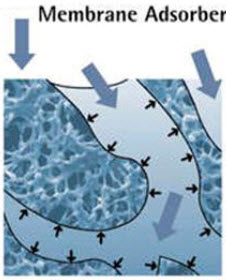Clemson University
Community for the latest research in new membrane materials.

Effect of Surface Area on the Protein Binding Capacity of Membrane based Cation-exchange Adsorbers
The Effect of Surface Area on the Protein Binding Capacity of Membranebased Cation-exchange Adsorbers
Introduction
•
An increased demand for protein therapeutics motivate the need for more efficient downstream processing.
Julie Robinson, Eboni Hobley Heather Chenette, Milagro Marroquin, Scott Husson
Department of Chemical and Biomolecular Engineering CLEMSON UNIVERSITY
Results
•
The 0.20 µm pore-size membranes were tested at three different flow rates: 3.85 , 7.70, and 12.83 mL/min
Discussion
•
Membrane chromatography offers lower pressure drop and higher throughput than conventional bead method
•
• •
Protein capture remains one of the slowest and most expensive steps of this process
The current method of resin-based chromatography has a low mass throughput.
Absorbance (mAU)
Typical Chromatograms
Unmodified 0.2 µm Membranes
1800
Sartorius-Stedim Biotech SA
Modified 0.2 µm Membranes
1600.00 1400.00
Absorbance (mAU)
A need exists for a high throughput technology that can accommodate larger batch sizes.
1600 1400 1200 1000 800 600 400 200 0 0.00 2.00 3.99 5.99 7.99 9.98 11.98 13.98 15.97 17.97 19.97 21.96 23.96 25.96 27.95
1200.00 1000.00 800.00 600.00 400.00 200.00 0.00 0.00
•
5.00 10.00 15.00 20.00 25.00 30.00
Crown ether monomer cap stabilizes acidic monomer in aprotic solution
Objectives
• Surface modify membranes to create cation-exchange
adsorbers with high protein binding capacity and high throughput
Volume (mL)
Volume (mL)
Lysozyme Binding and Elution
Flow Rate Approximate Dynamic Binding Recovery (%) (mL/min) Capacity (mg/mL) 3.85 7.7 12.83 5 ±2 15± 1 20 ±3 16.57 4.89 3.91
• • •
•Investigate the effect of membrane surface area (pore
size) on protein binding capacity of surface-modified membranes
Addition of ascorbic acid in 1:1 molar ratio reverses oxidation of Cu (I) catalyst in ATRP solution A dry layer thickness of 10 nm was targeted to accommodate 0.20 ?m pores. Elipsometry measurements of silicon wafers revealed actual thickness of 5 nm. Approximate Binding Capacity =
C0 = initial concentration Vd = dead volume (unmodified) VBr = breakthrough volume (modified) Vc = column volume
•Compare column performance across a range of flow
rates
Experimental Methods
• •
GE Life Sciences
Percent Recovery =
Conclusions
The data show how ATRP can be used to create cationexchange adsorbers and demonstrate the relationship between surface area and dynamic binding capacity
Surface Functionalization Initator: 2-BIB (2-Bromoisobutyryl bromide)
Atom Transfer Radical Polymerization (ATRP) Monomer: SPMAK (3-sulfopropyl methacrylate, potassium salt) Substrate: Membranes of 1.0, 0.45, and 0.20 µm pore sizes Solvent: DMSO (Dimethyl Sulfoxide) Catalyst: Cu (I)/HMTETA complex Monomer Cap: 18C6
Dynamic Binding Capacity Measurements Binding Buffer: 50 mM Tris Elution Buffer: 50 mM Tris + 1 M KCl Regeneration Buffer: 0.3 M KOH Protein: lysozyme in binding buffer
Future Work
• •
Investigate the effect of polymer chain grafting density on protein binding capacity of surface-modified membranes Determine the optimal polymerization time (chain length) to maximize binding capacity
Controlled Drug Delivery
Energy Storage
electrochemical devices and batteries using responsive membranes
Acknowledgements: This work was part of the Advanced Functional Membranes Research Experiences for Undergraduates program at Clemson University. Support for this REU program was provided by the National Science Foundation under award EEC 1061524. Visit our website at www.clemson.edu/ces/chbe/reu/index.html
Protein Separations
for low cost therapeutics
Advanced Functional Membranes REU
CO2 Recovery
to reduce the impacts of climate change
Water Purification
using self-cleaning membranes
Energy Conversion
membranes in fuel cells
